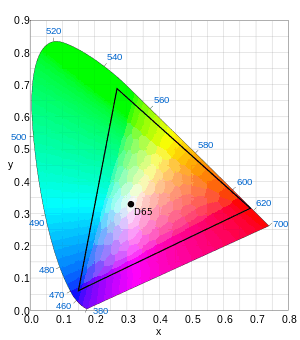DCI-P3

DCI-P3, or DCI/P3, is a common RGB color space for digital movie projection from the American film industry.[1]
History
Early history
In the CIE 1931 xy chromaticity diagram the DCI-P3 color space covers 45.5% of all chromaticities and 86.9% of Pointer’s gamut. In the CIE 1976 u’v’ chromaticity diagram the coverage is 41.7% and 85.5% respectively.[2] The blue primary color is the same as sRGB and Adobe RGB;[1] the red primary color is a monochromatic light source and has a wavelength of 615 nm. DCI-P3 was defined by the Digital Cinema Initiatives (DCI) organization and published by the Society of Motion Picture and Television Engineers (SMPTE) in SMPTE EG 432-1 and SMPTE RP 431-2.[3] As a step towards the implementation of the significantly wider Rec. 2020 it is expected to see adoption in television systems and in the home cinema domain.[4]
On November 10, 2010, SMPTE published SMPTE EG 432-1:2010.[5]
On April 6, 2011, SMPTE published SMPTE RP 431-2:2011.[6]
2015-2016
In September 2015, Apple's iMac desktop became the first consumer computer with a built-in wide-gamut display, supporting the P3 color space.
On January 4, 2016, the UHD Alliance announced their specifications for Ultra HD Premium which requires devices to display at least 90% of the DCI P3 color space.[7][8]
In March 2016, Apple's 9.7-inch iPad Pro shipped with a display supporting P3 color.
In August 2016, the Samsung Galaxy Note 7 shipped with an HDR display[9] with 100% DCI-P3 color gamut.[10]
In September 2016, Apple's iPhone 7 shipped with a wide-gamut display, supporting P3.[11]
In October 2016, Microsoft's Surface Studio desktop computer was unveiled, featuring P3 wide color.
In October 2016, Apple's new MacBook Pro notebook was released with a wide-gamut display, featuring support for P3.[12]
2017
In April 2017, Samsung released the Galaxy S8, which supports P3 wide color.[13]
In June 2017, Apple unveiled the second generation of the 12.9-inch iPad Pro and the new 10.5-inch iPad Pro, both shipped with a display supporting P3 color.
In June 2017, OnePlus 5 was released with this feature.[14]
In September 2017, Apple unveiled the iPhone 8 and 8 Plus with support for P3 color.[15]They also unveiled the iPhone X which also covers 103% of P3 color.[16][17][18]
In October, 2017, Google released the Pixel 2, which covers 95% of the P3 color standard, and the Pixel 2 XL, which covers 100%. [19]
In November 2017, HTC announced HTC U11+ phone with DCI-P3 color support [20].
In December 2017, Apple released iMac Pro, featuring P3 wide color.[21]
System colorimetry
| Color space | White point | Primary colors | ||||||
|---|---|---|---|---|---|---|---|---|
| xW | yW | xR | yR | xG | yG | xB | yB | |
| P3 D65 | 0.3127 | 0.3290 | 0.680 | 0.320 | 0.265 | 0.690 | 0.150 | 0.060 |
| DCI-P3 (Theater) | 0.314 | 0.351 | 0.680 | 0.320 | 0.265 | 0.690 | 0.150 | 0.060 |
DCI-P3 has a 25% larger color gamut than sRGB.[24]
References
- 1 2 "Color spaces". Technicolor SA. Archived from the original on 2016-02-03. Retrieved 2016-02-01.
- ↑ Kid Jansen (2014-02-19). "The Pointer's Gamut". tftcentral. Retrieved 2017-01-06.
- ↑ The Society of Motion Picture and Television Engineers, 2011, New York: RP 431-2, D-Cinema Quality – Reference Projector and Environment for the Display of DCDM in Review Rooms and Theaters
- ↑ Geoffrey Morrison (2015-04-12). "Ultra HD 4K TV color, part II: The (near) future". CNET. Retrieved 2016-02-01.
- ↑ "EG 432-1:2010 - Digital Source Processing — Color Processing for D-Cinema". Institute of Electrical and Electronics Engineers. 2010-11-10. Retrieved 2016-02-01.
- ↑ "RP 431-2:2011 - D-Cinema Quality — Reference Projector and Environment". Institute of Electrical and Electronics Engineers. 2011-04-06. Retrieved 2016-02-01.
- ↑ "UHD Alliance Defines Premium Home Entertainment Experience". Business Wire. 2016-01-04. Retrieved 2016-02-01.
- ↑ Andy Vandervell (2016-01-06). "What is Ultra HD Premium? New HDR standard explained". TrustedReviews. Time Inc. UK. Retrieved 2016-09-19.
- ↑ "The HDR screen of the Galaxy Note 7 could be the next big thing for phones". CNET. Retrieved 2017-04-09.
- ↑ "Galaxy Note7 OLED Display Technology Shoot-Out". www.displaymate.com. Retrieved 2017-04-09.
- ↑ Mike Wuerthele (2016-09-09). "Apple's Wide Color screen on the iPhone 7 will lead to more faithful color reproduction". AppleInsider. Retrieved 2016-09-19.
- ↑ "MacBook Pro - Technical Specifications". Apple. Retrieved 2017-09-15.
- ↑ Soneira, Raymond. "Galaxy S8 OLED Display Technology Shoot-Out". DisplayMate. Retrieved 4 April 2017.
- ↑ Rahman, Mishaal (29 June 2017). "Enable the OnePlus 5's DCI-P3 Wide Color Gamut Mode on the OnePlus 3T". xda-developers. Archived from the original on 29 June 2017. Retrieved 29 June 2017.
- ↑ "Microsoft Surface Studio Vs Apple iMac: Australian Specs And Pricing Compared". Lifehacker Australia. 2016-11-01. Retrieved 2017-09-15.
- ↑ "iPhone X - Technical Specifications". Apple. Retrieved 2017-09-15.
- ↑ "iPhone 8 - Technical Specifications". Apple. Retrieved 2017-09-15.
- ↑ "iPhone X OLED Display Technology Shoot-Out". www.displaymate.com. Retrieved 2018-01-02.
- ↑ "Pixel 2 Tech Specs - Google Store". store.google.com. Retrieved 2017-10-04.
- ↑ "HTC U11 Plus". HTC. Retrieved 3 November 2017.
- ↑ "iMac Pro - Technical Specifications". Apple. Retrieved 2017-08-18.
- ↑ Kid Jansen. "The Pointer's Gamut". TFT Central. Retrieved 2016-01-30.
- ↑ Rajan Joshi; Shan Liu; Gary Sullivan; Gerhard Tech; Ye-Kui Wang; Jizheng Xu; Yan Ye (2016-01-31). "HEVC Screen Content Coding Draft Text 5". JCT-VC. Retrieved 2016-01-31.
- ↑ Dean Jackson (2016-07-01). "Improving Color on the Web". WebKit. Retrieved 2016-09-19.